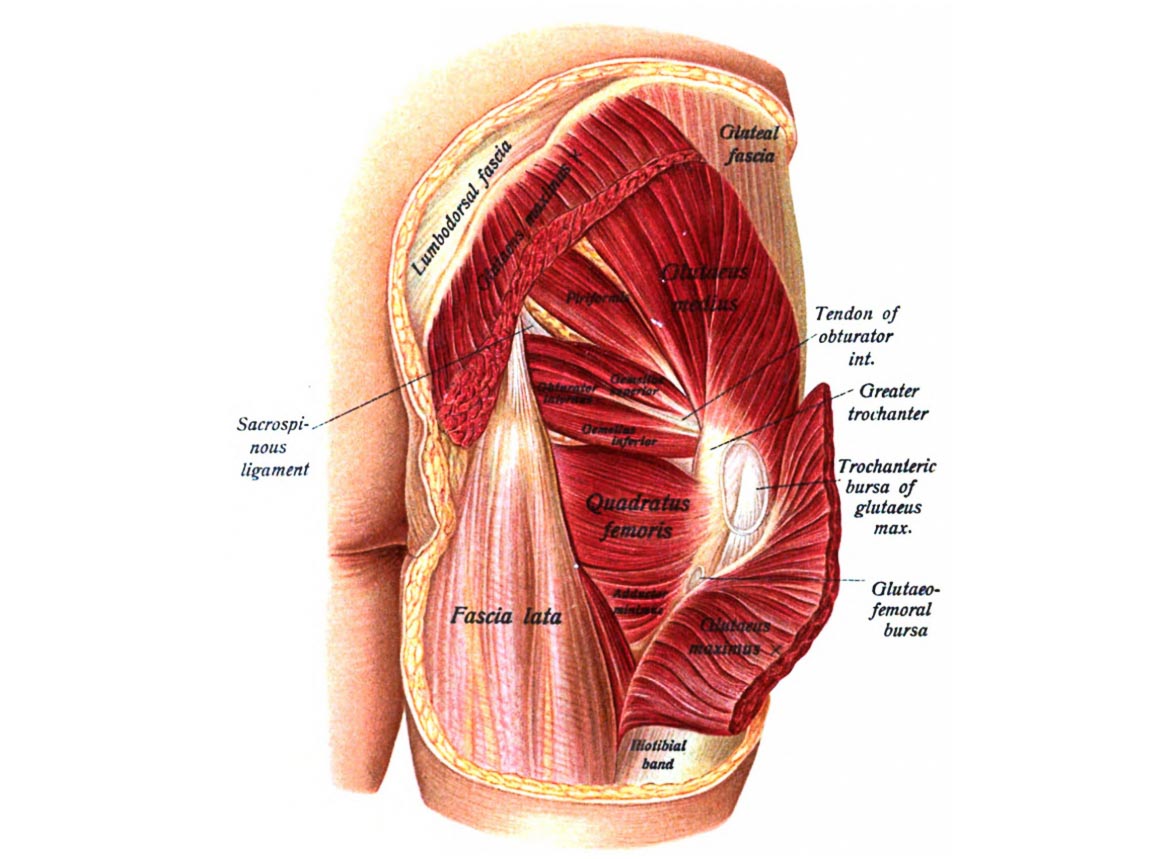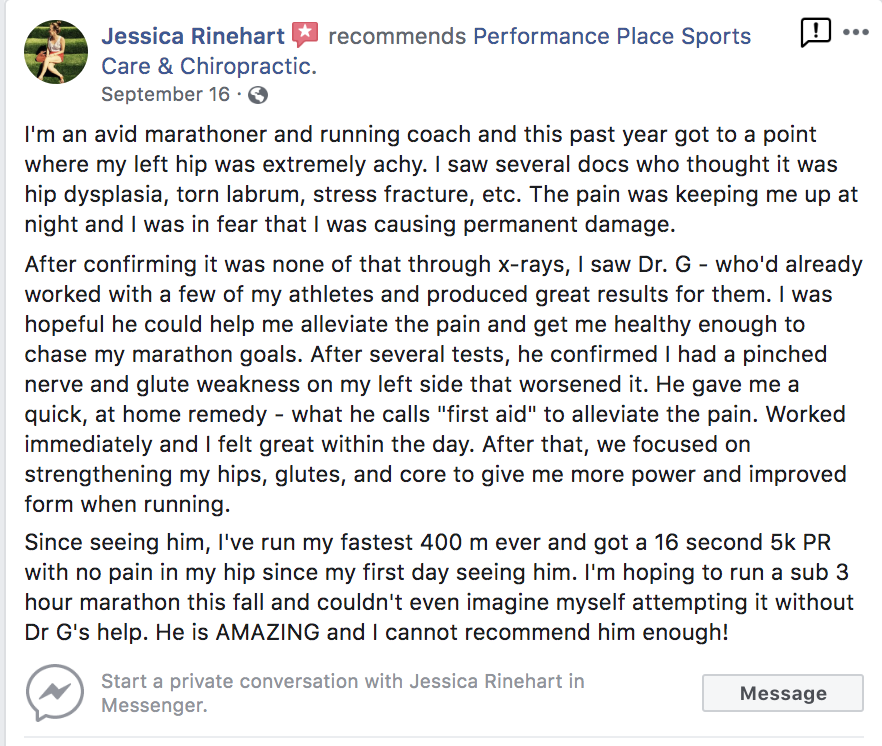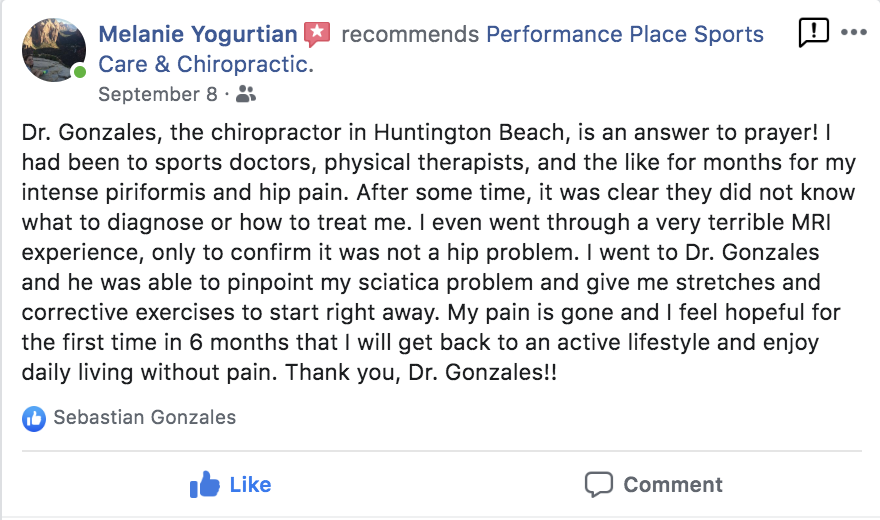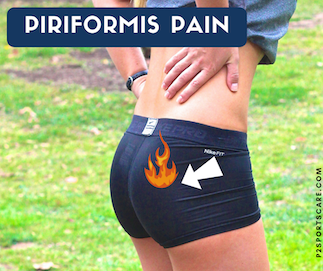What is Piriformis Syndrome
Piriformis Syndrome is a musculoskeletal condition of the hip, where the piriformis muscle becomes tight and often spasms. Local piriformis inflammation and spasm can irritate the sciatic nerve, which can create sciatica like symptoms of Numbness, tingling and electrical sensations into the leg and foot.
A correct diagnosis of Piriformis Syndrome is accomplished via detailed examination and history taking process. Expect this to take between 30-45 minutes.
Advanced imaging, such as MRI and MSK Ultrasound are often not required to meet a correct diagnosis. X-rays hold little to no value since the piriformis muscle, nor sciatic nerve can be seen on x-ray. Imaging often times shows normal findings and does not aid in confirming a diagnosis of Piriformis Syndrome.
Since Piriformis Syndrome is fairly uncommon, even seasoned clinicians have a hard time arriving at a correct diagnosis unless they are aware of the battery of tests used to rule out other possible diagnosis. Seek only the most experienced clinicians when looking to overcome Piriformis Syndrome. Incorrect diagnosis will yield poor recovery time.

Piriformis Syndrome Causes
Piriformis Syndrome often starts in the lateral buttocks region (one-sided) as pain, spasm, tension, tingling and/or numbness. Severity of discomfort varies and often times travels down the backside of the leg, calf and or to the bottom of the foot, mimicking sciatica.
Pressure while sitting on the piriformis muscle can increase pain. Prolonged sitting to a standing position can be painful. It can take a few minutes to normalize after rising from a chair. Walking up stairs, running, pushing a shopping cart, lifting weights all may provoke Piriformis Syndrome.
Common Misdiagnosis
- Lumbar spine disc herniation or inflammation
- Pinched low back nerve (S1 nerve root)
- Lumbar central stenosis
- Lumbar foraminal stenosis\
- SI joint sprain referred
Lumbar spine disc irritation and nerve root pressure are the most common reasons for piriformis muscle spasms. Typical recovery time to pain-free movement ranges from 1-3 weeks. Return to sport depends on how long you have been removed from the sport, yet in most cases under 2 months is a fair assumption.
The involvement of the lumbar spine disc and nerve roots are not always show on MRI, which perplexes some doctors and patients. MRIs are commonly taken while the subject is lying face up, which can change the image findings. With a position of comfort often being supine (lying face up), disc herniation and nerve root pressure will appear to be “normal,” as the MRI is not a dynamic, movement based image and can fail to see low back involvement while the patient is lying in a symptom free position.
The spine is dynamic and structural problems such as these will change based upon the patients positions and postures. The lack of visual MRI confirmation of the low back’s involvement is a “rookie doctors mistakes.” As we say, “you only make these mistakes once.” Ruling out lumbar spine involvement should be done with a cluster of physical examination test that skilled clinicians should know. And no, your back does not need to hurt to have low back structural involvement.
Since lumbar disc and nerve root involvement is so commonly the cause of piriformis tension (neurologic referred pain), it would be wise to rehabilitate the spine first and see the results. We will cover basics of rehabilitation later.
Treatment plans yielding little to no improvement in under 1 month should be discontinued in replaced with treatment that is more targeted at reduction of the “root problem.”
Self guided care (in the absence of clinician direction) tends to yield low recovery rates.
If you’ve been under the care of a physical therapist, chiropractor, acupuncture, massage therapist, medical doctor, or any other treatment plan and you have not had more than a 25% long-term improvement in under 2 months, it’s time to jump ship. Poor case mismanagement, poor recommendations of treatment, or patient non-compliance tends to be the reason many people do not recover.
Do yourself a favor and find a better treatment/ therapy suggestion that is something you can take part in to give yourself the best results.
EXPECTATIONS WHEN YOU
COME SEE US IN COSTA MESA:
MORE THAN 50% IMPROVEMENT WITHIN 4-6 SESSIONS
Most Cases
MORE RELIEF WITH LESS RISK
We Only Use High Reward/Low Risk Treatments
NO RIDICULOUS LONG-TERM TREATMENT PLANS
MORE ATTENTION WITH A SKILLED GUIDE
Even Though our Costa Mesa Chiropractor are Not A "Real Doctor" 🙂
MORE THAN A TYPICAL COSTA MESA CHIROPRACTOR
No Bone Cracking Required To Feel Good
NO QUACKERY
Dr. Gonzales & Costantino Only Uses Current Evidence-Informed Methods
CLICK HERE TO BOOK YOUR APPOINTMENT WITH A COSTA MESA CHIROPRACTOR
Piriformis Treatment Options
The most favorable treatment option (after a detailed examination and history) is figuring out what “first-aid” is for your recovery. Disc herniations, pinched nerves and stenosis all have different first aids.
- Disc herniation driven piriformis tension tends to respond to repeated lumbar spine extension first-aid exercises.
- Nerve pressure derived piriformis tension tends to respond well to side stretches away from the side of discomfort.
- Stenosis driven versions tend to respond well to child’s pose types of first-aid.
The correct “first aid” should yield a 30-50% improvement within a 7 day period as the body heals itself (most cases).
The First-Aid Exercise Phase: Following the first-aid phase, to reduce flare ups, application of spinal stiffening exercises and glute exercises tend to work. Corrective exercise should NEVER HURT. If it does, your doctor should suggest a regression of the exercise for a few days until your body can tolerate more challenges.
The Corrective Exercise Phase: Following the first week of implementation of corrective exercises, most people should feel a 75-90% improvement in piriformis spasms. Note: That is a total of 2-3 weeks of care.
Corrective exercises should be used for a 2-3 weeks time and used as an intermediate step of rehabilitation. The next step looks like weight training, yet it is program to strength for loads and objects you will encounter throughout your day.
This is a relatively pain-free period and many people tend to drop from care at this point, but beware. This is actually the most PRODUCTIVE time to decrease probably of the pain coming back. Mark my words…
The Loading Phase: Being able to navigate 20-40 lb weights in variations of movements will cover most people’s daily loads that can often trigger a flare up that may land you at square one again. Building strength and endurance to have a tolerance to these loads looks very much like weight training. Variations in weight training will be suggestion under supervision for 4-6 weeks. Total suggested weight training time varies but most need 6 weeks to 3 months total, which should all be symptoms free.
As you can see, treatment suggestions change based upon the stage of your condition.
Physical therapists and chiropractors both have minimal experience in piriformis treatment from their schooling. Mastery may need advanced skills and clinical experience before they are able to successfully manage this process. Not all physical therapists and chiropractors should be assumed to have these skills. I was no exception.
It’s best to screen your healthcare team. To screen your physical therapists and chiropractors’ knowledge of how to resolve your piriformis syndrome, ask for timelines, treatment standards and how they would assess your condition. Ask them if they require images. Remember a majority of people do NOT need images. Early imaging to “diagnose” is a marker of the lack of one’s physical examination skills. Imaging in these situations are needed to rule of sinister pathology like: cancer, tumors, cauda equina syndrome, AAA and more.
Piriformis injections and surgery are often not required for complete recovery.
Piriformis Treatment Testimonials
⭐️⭐️⭐️⭐️⭐️Piriformis Pain Gone in a Few Days
I’m an avid marathoner and running coach and this past year got to a point where my left hip was extremely achy. I saw several docs who thought it was hip dysplasia, torn labrum, stress fracture, etc. The pain was keeping me up at night and I was in fear that I was causing permanent damage.
After confirming it was none of that through x-rays, I saw Dr. G – who’d already worked with a few of my athletes and produced great results for them. I was hopeful he could help me alleviate the pain and get me healthy enough to chase my marathon goals. After several tests, he confirmed I had a pinched nerve and glute weakness on my left side that worsened it. He gave me a quick, at home remedy – what he calls “first aid” to alleviate the pain. Worked immediately and I felt great within the day. After that, we focused on strengthening my hips, glutes, and core to give me more power and improved form when running.
Since seeing him, I’ve run my fastest 400 m ever and got a 16 second 5k PR with no pain in my hip since my first day seeing him. I’m hoping to run a sub 3 hour marathon this fall and couldn’t even imagine myself attempting it without Dr G’s help. He is AMAZING and I cannot recommend him enough!
Jessica R. Long Beach CA

⭐️⭐️⭐️⭐️⭐️Piriformis Issues Gone
Dr. Gonzales, the chiropractor in Huntington Beach, is an answer to prayer! I had been to sports doctors, physical therapists, and the like for months for my intense piriformis and hip pain. After some time, it was clear they did not know what to diagnose or how to treat me.
I even went through a very terrible MRI experience, only to confirm it was not a hip problem. I went to Dr. Gonzales and he was able to pinpoint my sciatica problem and give me stretches and corrective exercises to start right away.
My pain is gone and I feel hopeful for the first time in 6 months that I will get back to an active lifestyle and enjoy daily living without pain. Thank you, Dr. Gonzales!!
Mel Y, Huntington Beach CA
If you’re suffering from Piriformis Syndrome, come see me. I specialize in lower back and hip regional conditions that will need to be ruled out in your case.
Read my Google and Yelp reviews. Our serve and dedication to your quick recovery is second to none.
Dr. Sebastian Gonzales DC, DACBPS®, CSCS
Huntington Beach CA
714-502-4243
Free insurance verification offered
Triwest Community Care Provider for Vets


